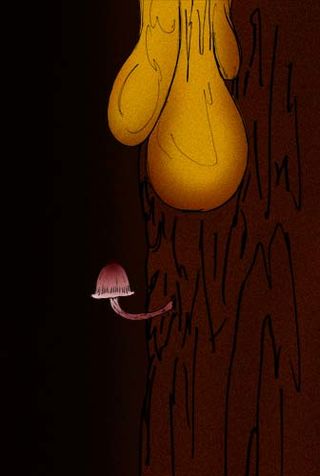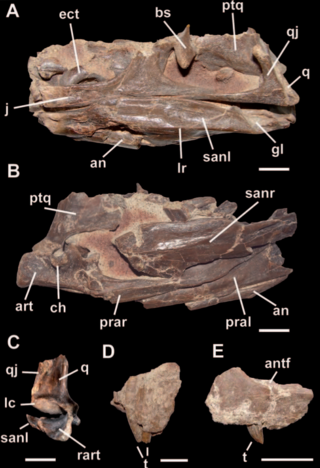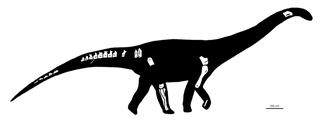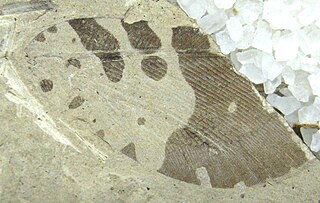
Ausia fenestrata is a curious Ediacaran period fossil represented by only one specimen 5 cm long from the Nama Group, a Vendian to Cambrian group of stratigraphic sequences deposited in the Nama foreland basin in central and southern Namibia. It has similarity to Burykhia from Ediacaran (Vendian) siliciclastic sediments exposed on the Syuzma River of Arkhangelsk Oblast, northwest Russia. This fossil is of the form of an elongate bag-like sandstone cast tapering to a cone on one end. The surface of the fossil is covered with oval depressions ("windows") regularly spaced over the surface in the manner of concentric/parallel rows. The taxonomic identity of Ausia is unresolved.

Zuul is a genus of herbivorous ankylosaurine dinosaur from the Campanian Judith River Formation of Montana. The type species is Zuul crurivastator. It is known from a complete skull and tail, which represents the first ankylosaurin known from a complete skull and tail club, as well as the most complete ankylosaurid specimen thus far recovered from North America. The specimen also preserved in situ osteoderms, keratin, and skin remains.

Protomycena is an extinct monotypic genus of gilled fungus in the family Mycenaceae, of order Agaricales. At present it contains the single species Protomycena electra, known from a single specimen collected in an amber mine in the Cordillera Septentrional area of the Dominican Republic. The fruit body of the fungus has a convex cap that is 5 mm (0.2 in) in diameter, with distantly spaced gills on the underside. The curved stipe is smooth and cylindrical, measuring 0.75 mm (0.030 in) thick by 10 mm (0.39 in) long, and lacks a ring. It resembles extant species of the genus Mycena. Protomycena is one of only five known agaric fungus species known in the fossil record and the second to be described from Dominican amber.

Skeemella clavula is an elongate animal from what is now the Middle Cambrian Wheeler Shale and Marjum lagerstätte of Utah. It has been classified with the vetulicolians.

Aurorazhdarcho is an extinct genus of ctenochasmatoid pterosaur known from the Late Jurassic period of what is now Bavaria, southern Germany.

Bicentenaria is an extinct genus of carnivorous coelurosaurian theropods which lived during the early Late Cretaceous (Cenomanian) Candeleros Formation of Argentina. It contains the type species, B. argentina.
Glyphoderma is an extinct genus of placodont reptile from the Middle Triassic of China with two known species, G. kangi and G. robusta. It differs from its relative Psephochelys in having three, rather than one, fused osteoderms on the posterior skull surface, and has an earlier temporal range, from the Ladinian epoch rather than the Late Triassic. Otherwise, it is similar in most respects to the other plachochelyids found in China. The name comes from the Greek 'γλυφος', 'sculpture' and 'δερμα', 'skin' referring to its unique carapace structure. The specific name honours a Mr. Kang Ximin.

Pseudogarypus synchrotron is an extinct species of pseudoscorpion in the family Pseudogarypidae known from only two Eocene fossils found in Europe. P. synchrotron is one of four species in the genus Pseudogarypus to have been described from fossils.

Longusunguis is an extinct genus of bohaiornithid enantiornithean dinosaur known from the Early Cretaceous of Liaoning Province, northeastern China. It contains a single species, Longusunguis kurochkini.

Archimyrmex is an extinct genus of ant in the formicid subfamily Myrmeciinae, described by palaeoentomologist Theodore Cockerell in 1923. The genus contains four described species, Archimyrmex rostratus, Archimyrmex piatnitzkyi, Archimyrmex smekali and Archimyrmex wedmannae. Archimyrmex is known from a group of Middle Eocene fossils which were found in North America, South America, and Europe. The genus was initially placed in the subfamily Ponerinae, but it was later placed in Myrmeciinae; it is now believed to be the ancestor of the extant primitive genus Myrmecia from Australia. Despite this, Archimyrmex is not a member to any tribe and is regarded as incertae sedis within Myrmeciinae. However, some authors believe Archimyrmex should be assigned as incertae sedis within Formicidae. These ants can be characterised by their large mandibles and body length, ranging from 13.2 to 30 mm. They also have long, thin legs and an elongated mesosoma (thorax) and petiole.

Ziapelta is an extinct genus of ankylosaurid. Its fossils have been found in the Hunter Wash and De-na-zin members of the Kirtland Formation of Upper Cretaceous (Campanian) New Mexico. It was named in 2014, in a research paper led by ankylosaur researcher Victoria Arbour. There is a single species in the genus, Ziapelta sanjuanensis. The genus is named after the Zia sun symbol, a stylized sun with four groups of rays, having religious significance to the Zia people of New Mexico, and the iconic symbol on the state flag of New Mexico, and pelta (Latin), a small shield, in reference to the osteoderms found on all ankylosaurids. The specific name is in reference to San Juan County and the San Juan basin, where the fossils were found. Multiple specimens have been described to date, though the fossils are mostly from the front part of the animal.

Gerontoformica is an extinct genus of stem-group ants. The genus contains thirteen described species known from Late Cretaceous fossils found in Asia and Europe. The species were described between 2004 and 2016, with a number of the species formerly being placed into the junior synonym genus Sphecomyrmodes.
Pachycondyla oligocenica is an extinct species of formicid in the ant subfamily Ponerinae known from a fossil found in eastern Asia.

Chiappeavis is a genus of enantiornithean bird from Early Cretaceous of northeastern China. The only species is Chiappeavis magnapremaxillo. Chiappeavis is classified within the family Pengornithidae. It is known from a single, almost complete skeleton including feather impressions discovered in the Jiufotang Formation of the Jehol Group. Long feathers formed a fan-shaped tail that was probably employed in flight.

Nullotitan is a genus of lithostrotian titanosaur from the Chorrillo Formation from Santa Cruz Province in Argentina. The type and only species is Nullotitan glaciaris. It was a contemporary of the ornithopod Isasicursor which was described in the same paper.

Palaeopsychops is an extinct genus of lacewing in the moth lacewings family Ithonidae. The genus is known from Early Eocene fossils found in Europe, and North America and is composed of ten species. The ten species can be informally separated into two species groups based on veination of the forewings, the "European" and "North American" groups. When first described, the genus was placed in the family Psychopsidae, but later was moved to Polystoechotidae, which itself is now considered a subgroup of the moth lacewings.
Yuanjiawaornis is an extinct genus of large enantiornithean bird known from the early Cretaceous of present-day China. It is monotypic, with only type species Y. virisosus known.
Conomedusites was a creature from the Ediacaran biota. The Ediacaran period ranged from 635 to 539 million years ago. Its fossil was first discovered in 1966 by Martin F. Glaessner and Mary Wade in South Australia. Conomedusites is believed to have been part of the phylum Cnidaria due to its similar structure to jellyfish and other cnidarians, but this is not known for certain. Conomedusites is thought to have been a stationary osmotroph.

Ichnusa is a genus of discoidal Cnidarians that existed during the Ediacaran, 635-541 Million Years ago (MYA) discovered on the island of Sardinia, Italy. The genus is monotypic, only containing the species Ichnusa cocozzi. Palaeontologists think that Ichnusa represented a cnidarian of unknown affinities, with I. cocozzi being put in the Scyphozoa.

Ramathallus is a genus of sessile lobate alga that represents a probable stem-Rhodophyte from the Proterozoic. The holotype of Ramathallus lobatus shows a cell structure with finger-like protrusions and a coating of non-cellular apatic. The cells have a dark granular material inside of them. The organism grew by apical growth and possessed pseudoparenchymatous thallus which in turn infer a possible affinity with the Florideophyceae. Many lobate protrusions radiated from the organisms centre composed out of pseudoparenchymatous tissue interpreted as "Cell fountains" made up of variably-sized cells. Ramathallus shares a close morphological similarity with the Ediacaran genera made up of pseudoparenchymatous, lobate fossils from the Doushantuo phosphorites of China Thallophyca, Thallophycoides, Paramecia and Gremiphyca.


















